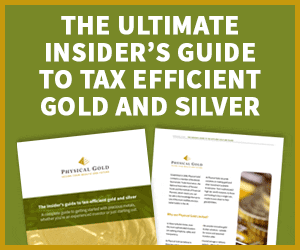Is the new 24 carat Britannia gold coin any good?
14/11/2012Daniel Fisher
Free & fully insured UK Delivery. Learn more
Secure & flexible payments. Learn more

Buyback Guarantee Learn more
In the past couple of weeks, we’ve seen the launch of the 2013 Gold Sovereign and Britannia gold coin from the Royal Mint.
While the new Sovereign coin is pretty much the same as recent issues, the latest Britannia gold coin represents an evolution. The Royal Mint has made the bold decision this year to produce their 1oz bullion coin in 24 carats for the first time. So why have they done this, and more importantly what are the consequences to UK gold investors?
Indications are that the Mint feels they can increase the global demand for their products by producing the 24-carat coin. There can be tax advantages in some countries for investors buying 24-carat gold rather than its diluted 22-carat version. Certainly, the Far Eastern market tends to demand pure gold, known as “4 nines gold” due to it being 99.99% pure, more than gold mixed with alloys. So undoubtedly there are advantages for the global market. But how will this change affect UK investors? Is it just as positive for us?
Interested in buying gold? Read our FREE 7 step guide to successful gold investing here
Let’s first of all deal with the misconception that you somehow get more gold with a 24-carat coin. You don’t! Generally, a 24-carat gold coin will weigh around 31g whereas its 22-carat cousin may weigh closer to 34g. So in both coins, you will receive around 31g of pure gold, with an additional 3g of alloy in the 22-carat coin. So there is no advantage with regards to gold quantity in 24-carat coins.
How about the way the two coins resist wear and tear? Hands down, the 22-carat coin is

This notion is supported by history and the majority of other bullion coins on the market. The fact that most gold coins are 22 carats suggests that this is the optimum mix for this type of gold investment. Certainly, the coin needs to be resilient due to its function as money. So in my mind, one of the reasons the Sovereign coin market is so deep is because coins of 100 years old are still in decent shape and desirable. Will the market for century-old 24-carat coins also prove successful? I don’t think so. The Royal Mint also seems to have lost focus on the original Britannia concept when it launched in 1987. After all, it was developed to piggyback on the success of the South African Krugerrand. This was and still is the most successful investment coin of all time. It was the first gold coin to possess exactly 1oz of gold. The Britannia if you like, was our version or copy of the Krugerrand. What is the purity of the Kruger? Well, 22 carats of course!
One interesting development to keep an eye on over the coming months is that of pricing. There will now be around 25 year’s worth of 22-carat Britannias on the secondary market, mixed with the new 24 carat coins. So how will the two coins price against each other? I guess only time will tell. The new pure coin may trade at a slight premium. There’s always a demand for the latest version of a coin, and this one is 24 carat after all! I’m not sure I would want to pay an additional premium for investment purposes for the reasons of value discussed earlier. Alternatively, we may see the older coins trading at a discount as the market may perceive these as less desirable. If this is the case, I will be snapping those up all day long as supply is limited.
So while the brand new Britannia gold coin is beautiful and will no doubt prove a huge success for the Royal Mint in opening up global demand for UK coins, the jury is still out on whether it will be as well-received on UK shores. Still, along with Sovereign gold coins, the Britannia (excluding the silver version) remains VAT exempt and Capital Gains Tax-free for UK residents so it’s certainly not worth discounting yet!
Click for more info on gold investment.
Live Gold Spot Price in Sterling. Gold is one of the densest of all metals. It is a good conductor of heat and electricity. It is also soft and the most malleable and ductile of the elements; an ounce (31.1 grams; gold is weighed in troy ounces) can be beaten out to 187 square feet (about 17 square metres) in extremely thin sheets called gold leaf.
Live Silver Spot Price in Sterling. Silver (Ag), chemical element, a white lustrous metal valued for its decorative beauty and electrical conductivity. Silver is located in Group 11 (Ib) and Period 5 of the periodic table, between copper (Period 4) and gold (Period 6), and its physical and chemical properties are intermediate between those two metals.